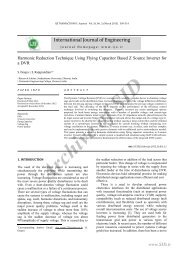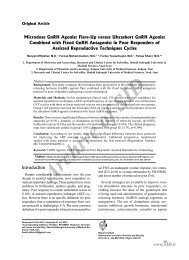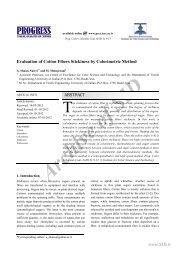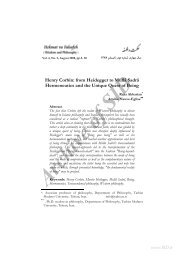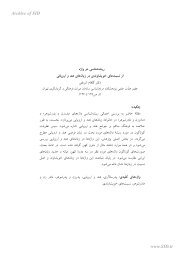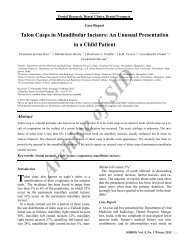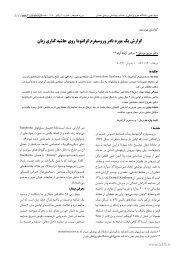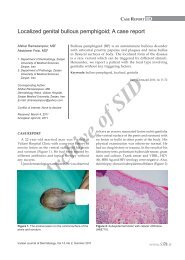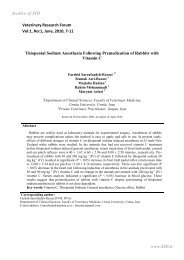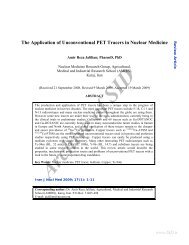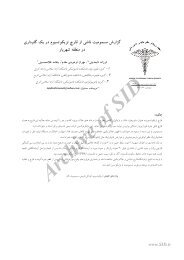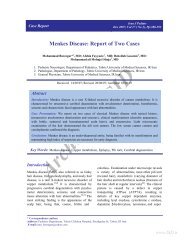efficacy of mtad, glyde and edta in debridement of curved root canals
efficacy of mtad, glyde and edta in debridement of curved root canals
efficacy of mtad, glyde and edta in debridement of curved root canals
You also want an ePaper? Increase the reach of your titles
YUMPU automatically turns print PDFs into web optimized ePapers that Google loves.
Archive <strong>of</strong> SID<br />
ORIGINAL ARTICLE<br />
Efficacy <strong>of</strong> MTAD, Glyde <strong>and</strong> EDTA <strong>in</strong> <strong>debridement</strong><br />
<strong>of</strong> <strong>curved</strong> <strong>root</strong> <strong>canals</strong><br />
Nahid Mohammadzadeh Akhlaghi 1* , DDS, MSD, Elahe Behrooz 2 , DDS, <strong>and</strong> Mohammad Ali<br />
Saghiri 3 , BS, MS, PhD Student<br />
1. Assistant Pr<strong>of</strong>essor <strong>of</strong> Endodontics, Dental School, Islamic Azad University <strong>of</strong> Medical Sciences, Tehran, Iran.<br />
2. Dentist, Islamic Azad University <strong>of</strong> Medical Sciences, Tehran, Iran.<br />
3. Master <strong>of</strong> Science <strong>in</strong> Biomaterials, PhD Student <strong>of</strong> Michigan University.<br />
Abstract<br />
Introduction: This study aimed to compare the <strong>efficacy</strong> <strong>of</strong> MTAD, Glyde <strong>and</strong> EDTA <strong>in</strong><br />
remov<strong>in</strong>g the post-preparation smear layer <strong>and</strong> debris produced <strong>in</strong> apical third <strong>of</strong> <strong>curved</strong> molar<br />
<strong>root</strong> <strong>canals</strong>.<br />
Materials <strong>and</strong> Methods: Forty extracted human maxillary first molars with <strong>curved</strong><br />
mesiobuccal <strong>canals</strong> (30˚-35˚), similar <strong>root</strong> lengths <strong>and</strong> morphologies were divided <strong>in</strong>to 3<br />
experimental groups (n=12) <strong>and</strong> one control group (n=4). Canals were prepared by RaCe rotary<br />
files <strong>and</strong> were treated with the follow<strong>in</strong>g materials between each two files: Group A (control<br />
group); 5 mL <strong>of</strong> distilled water, Group B; 1 mL <strong>of</strong> 17% ethylenediam<strong>in</strong>e tetra-acetic acid<br />
(EDTA) for 1 m<strong>in</strong>, Group C; BioPure MTAD (accord<strong>in</strong>g to the manufacturer’s <strong>in</strong>struction;<br />
5mL for 5 m<strong>in</strong>), <strong>and</strong> Group D; Glyde File Prep alternated with sodium hypochlorite (NaOCl)<br />
between each two files. Debridement <strong>of</strong> the apical third was evaluated us<strong>in</strong>g scann<strong>in</strong>g electron<br />
microscope (SEM) (×5000). The data were statistically analyzed us<strong>in</strong>g the Kruskal-Wallis <strong>and</strong><br />
Mann-Whitney U tests (P
Archive <strong>of</strong> SID<br />
smear layer, comb<strong>in</strong>ed use <strong>of</strong> NaOCl <strong>and</strong> other<br />
irrigants such as chelat<strong>in</strong>g agents are<br />
recommended (10).<br />
BioPure MTAD (Densply Tulsa Dental,<br />
Tulsa, OK) is a mixture <strong>of</strong> a tetracycl<strong>in</strong>e isomer<br />
(Doxycycl<strong>in</strong>e), an acid (citric acid) <strong>and</strong> a<br />
detergent (Tween 80), which was <strong>in</strong>troduced<br />
by Torab<strong>in</strong>ejad et al. <strong>in</strong> 2003 (11). MTAD<br />
removes the smear layer safely <strong>and</strong> completely<br />
(11), dis<strong>in</strong>fects the <strong>root</strong> canal efficiently (12)<br />
<strong>and</strong> is also biocompatible (13). A recent survey<br />
evaluat<strong>in</strong>g the current use <strong>of</strong> new endodontic<br />
technology <strong>and</strong> materials by diplomats <strong>of</strong> the<br />
American Board <strong>of</strong> Endodontists revealed the<br />
wide use <strong>of</strong> this irrigant dur<strong>in</strong>g endodontic<br />
treatments <strong>and</strong> retreatments. In retreatment<br />
cases with closed apices, MTAD has been the<br />
irrigant <strong>of</strong> choice (14).<br />
Glyde File Prep (Dentsply Maillefer,<br />
Ballaigues, Switzerl<strong>and</strong>) is a <strong>root</strong> canal<br />
conditioner consist<strong>in</strong>g <strong>of</strong> EDTA <strong>and</strong> carbamide<br />
peroxide <strong>in</strong> a water-soluble base. Accord<strong>in</strong>g to<br />
the manufacturer’s <strong>in</strong>structions, this gel is<br />
capable <strong>of</strong> remov<strong>in</strong>g the smear layer due to its<br />
EDTA content (10,15).<br />
17% EDTA (ethylenediam<strong>in</strong>e tetra-acetic acid)<br />
is a chelat<strong>in</strong>g agent capable <strong>of</strong> remov<strong>in</strong>g<br />
<strong>in</strong>organic material <strong>and</strong> the smear layer (10).<br />
Several <strong>in</strong>vestigations have shown that the use<br />
<strong>of</strong> 17% EDTA can cause <strong>in</strong>advertent dent<strong>in</strong>al<br />
wall erosion (11,16,17).<br />
Different studies have assessed the <strong>efficacy</strong> <strong>of</strong><br />
these materials <strong>in</strong> <strong>debridement</strong> <strong>of</strong> straight<br />
<strong>canals</strong> <strong>in</strong> s<strong>in</strong>gle-<strong>root</strong>ed teeth (10,11,15,16,18-<br />
21). There are no studies evaluat<strong>in</strong>g their<br />
<strong>efficacy</strong> <strong>in</strong> reach<strong>in</strong>g <strong>and</strong> debrid<strong>in</strong>g the apical<br />
third <strong>of</strong> <strong>curved</strong> <strong>root</strong> <strong>canals</strong>. The objective <strong>of</strong><br />
this study was to compare MTAD, Glyde <strong>and</strong><br />
17% EDTA’s effectiveness <strong>in</strong> <strong>curved</strong><br />
mesiobuccal <strong>canals</strong> <strong>of</strong> upper first molars.<br />
Materials <strong>and</strong> Methods<br />
Forty virg<strong>in</strong> healthy extracted human maxillary<br />
first molars with mesiobuccal canal curvatures<br />
rang<strong>in</strong>g between 30˚-35˚ (accord<strong>in</strong>g to<br />
Schneider’s method (22)) with similar <strong>root</strong><br />
lengths were selected for this study. After<br />
access cavity preparation, the work<strong>in</strong>g lengths<br />
were determ<strong>in</strong>ed K-file size #10 (Dentsply<br />
Maillefer, Ballaigues, Switzerl<strong>and</strong>). Samples<br />
were r<strong>and</strong>omly divided <strong>in</strong>to 4 groups A, B, C<br />
IEJ -Volume 4, Number 2, Spr<strong>in</strong>g 2009<br />
Debridement <strong>efficacy</strong><br />
(n=12) <strong>and</strong> D (n=4); A be<strong>in</strong>g the positive<br />
control group. After cod<strong>in</strong>g the samples,<br />
mesiobuccal <strong>canals</strong> were <strong>in</strong>strumented us<strong>in</strong>g<br />
RaCe rotary files (FKG, Dentaire, La chaux-defonds,<br />
Switzerl<strong>and</strong>) <strong>in</strong> the follow<strong>in</strong>g crowndown<br />
sequence: #40 (0.1), #35 (0.08), #30<br />
(0.06), #25 (0.06). A size #30 (0.06) was used<br />
as the master apical file (MAF) <strong>in</strong> all the<br />
samples. In group D, Glyde File Prep <strong>and</strong><br />
NaOCl were used alternately between each<br />
<strong>in</strong>strument accord<strong>in</strong>g to the manufacturer’s<br />
<strong>in</strong>struction. The specimens <strong>in</strong> groups A, B <strong>and</strong><br />
C were irrigated with 1 mL <strong>of</strong> 5.25% NaOCl<br />
(Samen Pharmaceuticals, Mashhad, Iran)<br />
between each file us<strong>in</strong>g a 28-gauge needle<br />
(DENTSPLY Tulsa Dental, Tulsa, OK) <strong>and</strong><br />
were f<strong>in</strong>ally irrigated 1-1.5 mm short <strong>of</strong> the<br />
work<strong>in</strong>g lengths with one <strong>of</strong> the follow<strong>in</strong>g<br />
solutions:<br />
Group A: (positive control): 5 mL <strong>of</strong> distilled<br />
water; Group B: 1 mL <strong>of</strong> 17% EDTA (Asia<br />
Chemi Teb Mfg, Tehran, Iran) for 1 m<strong>in</strong>ute;<br />
Group C: 5 mL <strong>of</strong> BioPure MTAD for 5<br />
m<strong>in</strong>utes. Accord<strong>in</strong>g to the manufacturer’s<br />
<strong>in</strong>struction MTAD should be freshly prepared<br />
before f<strong>in</strong>al irrigation <strong>of</strong> the <strong>root</strong> <strong>canals</strong>. As<br />
recommended by the manufacturer, 5 mL<br />
dosages were used for each canal. Content <strong>of</strong><br />
the 5 mL syr<strong>in</strong>ges was gradually <strong>in</strong>jected <strong>in</strong>to<br />
the powder bottle <strong>and</strong> the comb<strong>in</strong>ation was<br />
gently shaken for 60 seconds with the syr<strong>in</strong>ge<br />
attached to the bottle. Once completely mixed<br />
the solution was drawn <strong>in</strong>to the 5 mL delivery<br />
syr<strong>in</strong>ges, the syr<strong>in</strong>ge was removed from the<br />
bottle <strong>and</strong> after attach<strong>in</strong>g the 28 gauge needle<br />
the <strong>canals</strong> were irrigated as follows: the needle<br />
was passively placed <strong>in</strong>to the canal space, 1-1.5<br />
mm short <strong>of</strong> work<strong>in</strong>g length <strong>and</strong> 1 mL <strong>of</strong> the<br />
solution was slowly <strong>in</strong>jected <strong>in</strong>to the canal. A<br />
#15 cotton-wrapped barbed broach was placed<br />
to work<strong>in</strong>g length <strong>and</strong> left <strong>in</strong>side the canal<br />
space for 4 m<strong>in</strong>. Subsequently the barbed<br />
broach was removed <strong>and</strong> the solution<br />
suctioned. The canal was r<strong>in</strong>sed with the<br />
rema<strong>in</strong><strong>in</strong>g 4 mL <strong>of</strong> the solution for 1 m<strong>in</strong> (total<br />
irrigation time <strong>of</strong> 5 m<strong>in</strong>).<br />
Before SEM preparation, all samples were<br />
irrigated with 10 mL <strong>of</strong> distilled water to<br />
remove any remnants <strong>of</strong> the f<strong>in</strong>al irrigant <strong>and</strong><br />
the apical thirds were def<strong>in</strong>ed by 2 grooves<br />
on the buccal <strong>and</strong> l<strong>in</strong>gual surfaces to facilitate<br />
۵٩<br />
www.SID.ir
Archive <strong>of</strong> SID<br />
Akhlaghi et al.<br />
Figure 1. SEM <strong>of</strong> the dent<strong>in</strong>al surfaces <strong>in</strong> the apical third <strong>of</strong> the samples (orig<strong>in</strong>al magnification ×5,000).<br />
(A) control group. (B) 17% EDTA-treated sample. (C) MTAD-treated sample. (D) Glyde-treated sample.<br />
Table 1. The percentage <strong>of</strong> frequency for smear layer <strong>and</strong> debris removal <strong>in</strong> the four groups<br />
Groups removal<br />
Debris removal Smear layer<br />
Scores 1 2 3 4 5 1 2 3 4 5<br />
EDTA (n=12) 83.3 16.7 0 0 0 25 75 0 0 0<br />
MTAD (n=12) 100 0 0 0 0 91.7 8.3 0 0 0<br />
Glyde (n=12) 0 58.3 25 16.7 0 0 0 16.7 83.3 0<br />
Control (n=4) 0 0 25 75 0 0 0 0 100 0<br />
SEM analysis. The mesiobuccal <strong>root</strong>s were<br />
separated; vertically grooved on the buccal <strong>and</strong><br />
l<strong>in</strong>gual surfaces with a diamond disc without<br />
transgress<strong>in</strong>g <strong>in</strong>to the <strong>canals</strong>, <strong>and</strong> split<br />
longitud<strong>in</strong>ally. Half <strong>of</strong> each sample was<br />
r<strong>and</strong>omly chosen, placed <strong>in</strong> 2% glutaraldehyde<br />
for 24 hours <strong>and</strong> then r<strong>in</strong>sed 3 times with a<br />
sodium cacodylate buffered solution (0.1 M,<br />
pH 7.2). After <strong>in</strong>cubation <strong>in</strong> osmium tetroxide<br />
for 1 hour, the samples were dessicated with<br />
ascend<strong>in</strong>g concentrations <strong>of</strong> ethyl alcohol (30-<br />
100%), placed <strong>in</strong> a desicator for 24 hours <strong>and</strong><br />
mounted on a metallic stub. After coat<strong>in</strong>g the<br />
samples with 20µ <strong>of</strong> gold, SEM photomicrographs<br />
were taken us<strong>in</strong>g a back scatter mode<br />
(XL30, Philips, Holl<strong>and</strong>) (×5000). Three<br />
observers scored the amount <strong>of</strong> smear layer <strong>and</strong><br />
debris <strong>in</strong> a bl<strong>in</strong>d manner accord<strong>in</strong>g to Schäfer’s<br />
grad<strong>in</strong>g criteria (23). Scores 1 <strong>and</strong> 2<br />
represented acceptable <strong>debridement</strong>; scores 3, 4<br />
<strong>and</strong> 5 represented unacceptable <strong>debridement</strong>s.<br />
The data were statistically analyzed us<strong>in</strong>g the<br />
Kruskal-Wallis <strong>and</strong> Mann-Whitney U tests<br />
(P
Archive <strong>of</strong> SID<br />
alone is <strong>in</strong>effective <strong>in</strong> smear layer <strong>and</strong> debris<br />
removal (10,11,19).<br />
Glyde also failed to adequately remove smear<br />
layer <strong>in</strong> the apical region <strong>in</strong> this study as well<br />
as others (15,29). Lim et al. (10) reported no<br />
significant difference between the effect <strong>of</strong><br />
Glyde <strong>and</strong> EDTA <strong>in</strong> the apical third <strong>of</strong> <strong>canals</strong>.<br />
Both were more effective than NaOCl, with<br />
significant superiority <strong>in</strong> the coronal <strong>and</strong><br />
middle thirds. They used s<strong>in</strong>gle-<strong>root</strong>ed teeth<br />
with less <strong>root</strong> curvature (
Archive <strong>of</strong> SID<br />
Akhlaghi et al.<br />
3. Brännström M, Nyborg H. - Cavity treatment with<br />
a microbicidal fluoride solution: growth <strong>of</strong> bacteria <strong>and</strong><br />
effect on the pulp. J Prosthet Dent 1973;30:303-10.<br />
4. Kokkas AB, Boutsioukis ACh, Vassiliadis LP,<br />
Stavrianos CK. The <strong>in</strong>fluence <strong>of</strong> the smear layer on<br />
dent<strong>in</strong>al tubule penetration depth by three different <strong>root</strong><br />
canal sealers: an <strong>in</strong> vitro study. J Endod 2004;30:100-<br />
2.<br />
5. Eldeniz AU, Erdemir A, Belli S. Shear bond<br />
strength <strong>of</strong> three res<strong>in</strong> based sealers to dent<strong>in</strong> with <strong>and</strong><br />
without the smear layer. J Endod 2005;31:293-6.<br />
6. De-Deus G, Soares J, Leal F, Luna AS, Fidel S,<br />
Fidel RA. Similar glucose leakage pattern on smearcovered,<br />
EDTA-treated <strong>and</strong> BioPure MTAD-treated<br />
dent<strong>in</strong>. J Endod 2008;34:459-62.<br />
7. Cobankara FK, Adanr N, Belli S. Evaluation <strong>of</strong><br />
the <strong>in</strong>fluence <strong>of</strong> smear layer on the apical <strong>and</strong> coronal<br />
seal<strong>in</strong>g ability <strong>of</strong> two sealers. J Endod 2004;30:406-9.<br />
8. Shahravan A, Haghdoost AA, Adl A, Rahimi H,<br />
Shadifar F. Effect <strong>of</strong> smear layer on seal<strong>in</strong>g ability <strong>of</strong><br />
canal obturation: a systematic review <strong>and</strong> metaanalysis.<br />
J Endod 2007;33:96-105.<br />
9. Zehnder M. Root canal irrigants. J Endod<br />
2006;32:389-98.<br />
10. Lim TS, Wee TY, Choi MY, Koh WC, Sae-Lim<br />
V. Light <strong>and</strong> scann<strong>in</strong>g electron microscopic evaluation<br />
<strong>of</strong> Glyde File Prep <strong>in</strong> smear layer removal. Int Endod J<br />
2003;36:336-43.<br />
11. Torab<strong>in</strong>ejad M, Khademi AA, Babagoli J, Cho Y,<br />
Johnson WB, Bozhilov K, Kim J, Shabahang S. A new<br />
solution for the removal <strong>of</strong> the smear layer. J Endod<br />
2003;29:170-5.<br />
12. Shabahang S, Pouresmail M, Torab<strong>in</strong>ejad M. In<br />
vitro antimicrobial <strong>efficacy</strong> <strong>of</strong> MTAD <strong>and</strong> sodium<br />
hypochlorite. J Endod 2003;29:450-2.<br />
13. Zhang W, Torab<strong>in</strong>ejad M, Li Y. Evaluation <strong>of</strong><br />
cytotoxicity <strong>of</strong> MTAD us<strong>in</strong>g the MTT-tetrazolium<br />
method. J Endod 2003;29:654-7.<br />
14. Lee M, W<strong>in</strong>kler J, Hartwell G, Stewart J, Ca<strong>in</strong>e R.<br />
Current trends <strong>in</strong> endodontic practice: emergency<br />
treatments <strong>and</strong> technological armamentarium. J Endod<br />
2009;35:35-9.<br />
15. Hülsmann M, Heckendorff M, Schäfers F.<br />
Comparative <strong>in</strong>-vitro evaluation <strong>of</strong> three chelator<br />
pastes. Int Endod J 2002;35:668-79.<br />
16. Calt S, Serper A. Time-dependent effects <strong>of</strong><br />
EDTA on dent<strong>in</strong> structures. J Endod 2002;28:17-9.<br />
17. Niu W, Yoshioka T, Kobayashi C, Suda H. A<br />
scann<strong>in</strong>g electron microscopic study <strong>of</strong> dent<strong>in</strong>al<br />
erosion by f<strong>in</strong>al irrigation with EDTA <strong>and</strong> NaOCl<br />
solutions. Int Endod J 2002;35:934-9.<br />
18. T<strong>in</strong>az AC, Karadag LS, Alaçam T, Mihçioglu T.<br />
Evaluation <strong>of</strong> the smear layer removal effectiveness <strong>of</strong><br />
EDTA us<strong>in</strong>g two techniques: an SEM study. J<br />
Contemp Dent Pract 2006;7:9-16.<br />
19. Khedmat S, Shokouh<strong>in</strong>ejad N. Comparison <strong>of</strong> the<br />
<strong>efficacy</strong> <strong>of</strong> three chelat<strong>in</strong>g agents <strong>in</strong> smear layer<br />
removal. J Endod 2008;34:599-602.<br />
20. Gr<strong>and</strong><strong>in</strong>i S, Balleri P, Ferrari M. Evaluation <strong>of</strong><br />
Glyde File Prep <strong>in</strong> comb<strong>in</strong>ation with sodium<br />
hypochlorite as a <strong>root</strong> canal irrigant. J Endod<br />
2002;28:300-3.<br />
21. Pérez-Heredia M, Ferrer-Luque CM, González-<br />
Rodríguez MP. The effectiveness <strong>of</strong> different acid<br />
irrigat<strong>in</strong>g solutions <strong>in</strong> <strong>root</strong> canal clean<strong>in</strong>g after h<strong>and</strong><br />
<strong>and</strong> rotary <strong>in</strong>strumentation. J Endod 2006;32:993-7.<br />
22. Schneider SW. A comparison <strong>of</strong> canal<br />
preparations <strong>in</strong> straight <strong>and</strong> <strong>curved</strong> <strong>root</strong> <strong>canals</strong>. Oral<br />
Surg Oral Med Oral Pathol 1971;32:271-5.<br />
23. Schäfer E, Schl<strong>in</strong>gemann R. Efficiency <strong>of</strong> rotary<br />
nickel-titanium K3 <strong>in</strong>struments compared with<br />
sta<strong>in</strong>less steel h<strong>and</strong> K-Flex<strong>of</strong>ile. Part 2. Clean<strong>in</strong>g<br />
effectiveness <strong>and</strong> shap<strong>in</strong>g ability <strong>in</strong> severely <strong>curved</strong><br />
<strong>root</strong> <strong>canals</strong> <strong>of</strong> extracted teeth. Int Endod J<br />
2003;36:208-17.<br />
24. Crumpton BJ, Goodell GG, McClanahan SB.<br />
Effects on smear layer <strong>and</strong> debris removal with vary<strong>in</strong>g<br />
volumes <strong>of</strong> 17% REDTA after rotary <strong>in</strong>strumentation.<br />
J Endod 2005;31:536-8.<br />
25. Nguy D, Sedgley C. The <strong>in</strong>fluence <strong>of</strong> canal<br />
curvature on the mechanical <strong>efficacy</strong> <strong>of</strong> <strong>root</strong> canal<br />
irrigation <strong>in</strong> vitro us<strong>in</strong>g real-time imag<strong>in</strong>g <strong>of</strong><br />
biolum<strong>in</strong>escent bacteria. J Endod 2006;32:1077-80.<br />
26. Falk KW, Sedgley CM. The <strong>in</strong>fluence <strong>of</strong><br />
preparation size on the mechanical <strong>efficacy</strong> <strong>of</strong> <strong>root</strong><br />
canal irrigation <strong>in</strong> vitro. J Endod 2005;31:742-5.<br />
27. Torab<strong>in</strong>ejad M, Cho Y, Khademi AA, Bakl<strong>and</strong><br />
LK, Shabahang S. The effect <strong>of</strong> various concentrations<br />
<strong>of</strong> sodium hypochlorite on the ability <strong>of</strong> MTAD to<br />
remove the smear layer. J Endod 2003;29:233-9.<br />
28. Khademi A, Yazdizadeh M, Feizianfard M.<br />
Determ<strong>in</strong>ation <strong>of</strong> the m<strong>in</strong>imum <strong>in</strong>strumentation size for<br />
penetration <strong>of</strong> irrigants to the apical third <strong>of</strong> <strong>root</strong> canal<br />
systems. J Endod 2006;32:417-20.<br />
29. Ahn A, Yu T. Effects <strong>of</strong> irrigation solutions on<br />
smear layer us<strong>in</strong>g light speed <strong>in</strong>strumentation. J Dent<br />
Res 2000;79:527 (abstract).<br />
30. Scelza MF, Antoniazzi JH, Scelza P. Efficacy <strong>of</strong><br />
f<strong>in</strong>al irrigation--a scann<strong>in</strong>g electron microscopic<br />
evaluation. J Endod 2000;26:355-8.<br />
31. Tay FR, Pashley DH, Loush<strong>in</strong>e RJ, Doyle MD,<br />
Gillespie WT, Weller RN, K<strong>in</strong>g NM. Ultrastructure <strong>of</strong><br />
smear layer-covered <strong>in</strong>traradicular dent<strong>in</strong> after<br />
irrigation with BioPure MTAD. J Endod 2006;32:218-<br />
21.<br />
32. Tay FR, Hosoya Y, Loush<strong>in</strong>e RJ, Pashley DH,<br />
Weller RN, Low DC. Ultrastructure <strong>of</strong> <strong>in</strong>traradicular<br />
dent<strong>in</strong> after irrigation with BioPure MTAD. II. The<br />
consequence <strong>of</strong> obturation with an epoxy res<strong>in</strong>-based<br />
sealer. J Endod 2006;32:473-7.<br />
33. Saito K, Webb TD, Imamura GM, Goodell GG.<br />
Effect <strong>of</strong> shortened irrigation times with 17% ethylene<br />
diam<strong>in</strong>e tetra-acetic acid on smear layer removal after<br />
rotary canal <strong>in</strong>strumentation. J Endod 2008;34:1011-4.<br />
34. Gr<strong>and</strong>e NM, Plot<strong>in</strong>o G, Falanga A, Pomponi M,<br />
Somma F. Interaction between EDTA <strong>and</strong> sodium<br />
hypochlorite: a nuclear magnetic resonance analysis. J<br />
Endod 2006;32:460-4.<br />
۶٢ IEJ -Volume 4, Number 2, Spr<strong>in</strong>g 2009<br />
www.SID.ir



